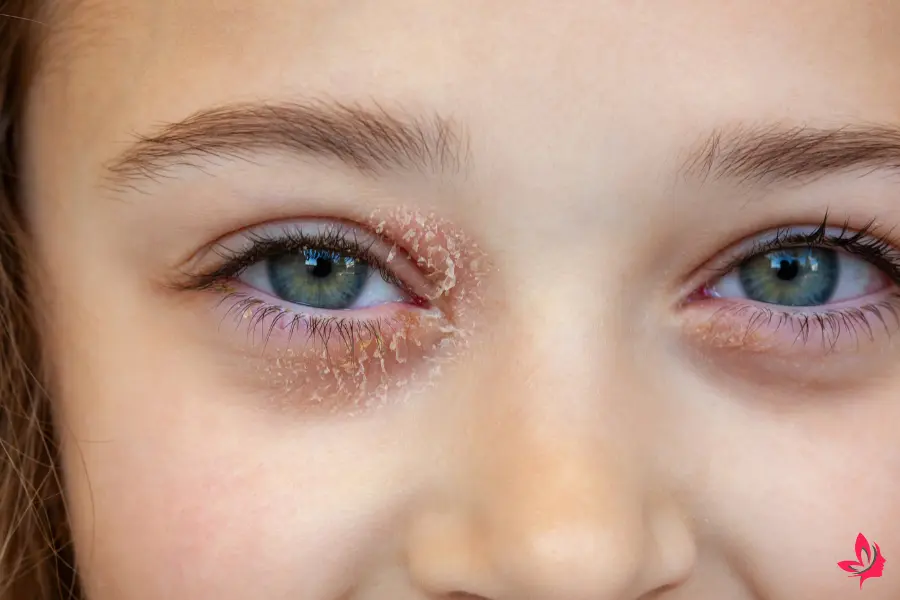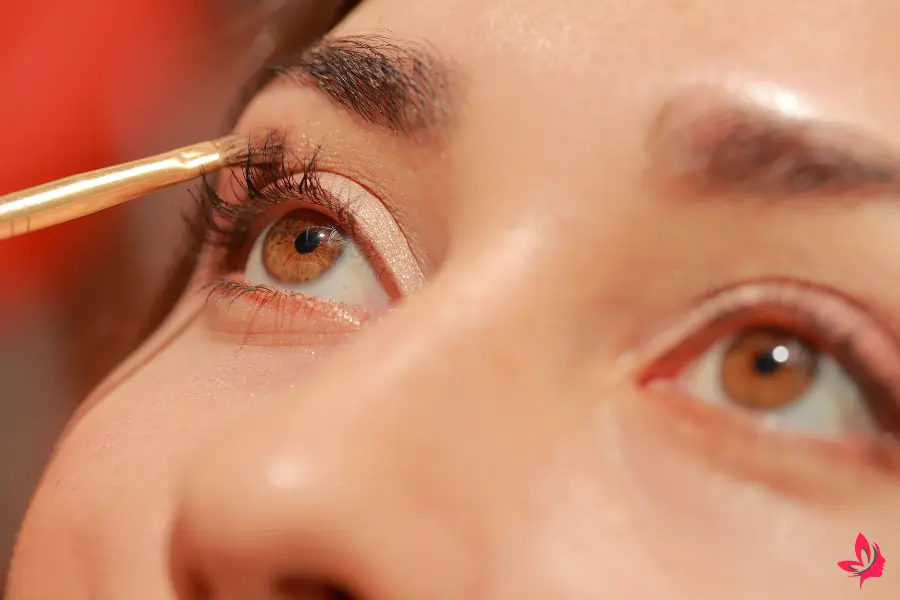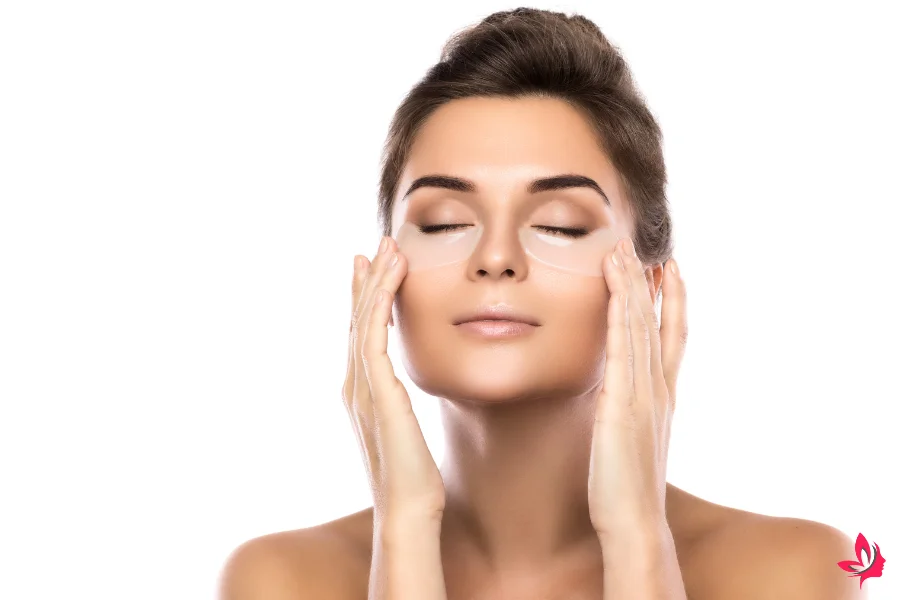Home remedies for eyelid dermatitis can soothe itchy, irritated skin for those struggling with redness and discomfort around the eyes.
Simple steps, such as warm compresses, gentle cleansing, and hypoallergenic creams, can help improve comfort and appearance.
These methods may reduce irritation without harsh chemicals and offer relief for sensitive skin.
Many people want to care for their eyelids at home because the skin around the eyes is thin and delicate.
By focusing on gentle habits, most can find safe and effective relief from symptoms.
Understanding Eyelid Dermatitis and Its Types

Eyelid eczema is a common condition that affects the delicate eyelid skin and can cause discomfort and irritation.
Recognizing the different types and symptoms helps you choose the best treatment and avoid common triggers.
What Is Eyelid Eczema and How Does It Develop?
Eyelid eczema, or eyelid dermatitis, means inflammation and irritation of the eyelid skin.
This area is thin and sensitive, so it is more vulnerable to external irritants, cosmetic products, or an overstimulated immune response.
Direct contact with allergens, such as eye makeup, harsh ingredients, or airborne particles, can trigger an inflammatory reaction.
Frequent touching of the eye area or the use of contact lenses that carry allergens can also trigger symptoms, especially in individuals with sensitive skin or pre-existing skin conditions.
Home remedies such as cool compresses, gentle moisturizers, and natural ingredients are often the first step.
In severe cases, prescription medications or medical advice may be needed.
Avoiding triggers and following a gentle skin care routine helps manage symptoms and reduces the risk of infection.
Types of Eczema: Atopic, Allergic, and Irritant Contact Dermatitis
Three main types of eczema can affect the eye area:
| Type of Dermatitis | Causes & Triggers | Key Features |
|---|---|---|
| Atopic Dermatitis | Linked to other allergic conditions like hay fever or asthma, an overactive immune system | Itchy, dry skin, often in people with allergies |
| Allergic Contact Dermatitis | Immune reaction to substances touching the skin (e.g., nail polish, eye cream preservatives, fragrances); identified by patch testing | Triggered by specific allergens; patch testing is helpful |
| Irritant Contact Dermatitis | Repeated exposure to harsh ingredients (soaps, detergents) | Damaged skin barrier, frequent flare-ups |
Identifying the type of eczema helps guide treatment and prevent future flare-ups.
See the Cleveland Clinic’s overview of eyelid dermatitis for more details.
Common Symptoms of Eyelid Dermatitis on the Eye Area
Eyelid dermatitis usually shows these symptoms:
- Redness and swelling along the eyelid edge
- Dry, flaky skin that may crack or peel
- Itchy eyelids or a burning feeling, which can get worse with scratching
- Sometimes, scaly skin or a feeling of tightness in the affected area
Individuals with allergies, sensitive skin, or those exposed to pollen and dust are at a higher risk of experiencing symptoms.
Scratching can worsen symptoms and, in severe cases, lead to infection or chronic skin changes.
Read about eyelid dermatitis symptoms to know when to seek treatment beyond home remedies.
Common Triggers and Risk Factors for Eyelid Dermatitis

Eyelid dermatitis often starts when delicate eyelid skin comes into contact with specific triggers or certain health conditions.
Symptoms include red, itchy eyelids, flaky skin, and swelling.
Knowing the causes is the first step to finding treatment or safe home remedies.
Environmental Factors and Airborne Allergens Affecting Sensitive Skin
Pollen, dust, and pet dander are common triggers of eyelid eczema, also known as atopic dermatitis.
Airborne allergens can cause inflammation, leading to itchy eyelids and irritated skin.
Individuals with sensitive skin may experience more severe symptoms during allergy season.
Pollution, smoke, and temperature fluctuations can compromise the skin barrier, increasing the likelihood of irritation.
People with a history of atopic eczema face a higher risk of eyelid dermatitis.
Using air purifiers or keeping windows closed on high-pollen days can help reduce flare-ups.
Contact Eczema: The Role of Eye Makeup and Cosmetic Products
Direct contact with eye makeup or harsh cosmetic products is a significant contributor to eyelid contact eczema.
Preservatives, fragrances, and colorants in cosmetics often trigger allergic or irritant contact dermatitis.
People who use waterproof makeup may notice more symptoms because stronger removers are needed.
Many products around the eye contain harsh ingredients that damage the skin barrier.
Choosing products labeled for sensitive skin and avoiding expired or shared makeup lowers the risk of allergic reactions.
If symptoms persist, consider switching to hypoallergenic or fragrance-free options.
Food Allergies, Hay Fever, and Their Link to Eczema Flare-Ups
Food allergies can cause eczema flare-ups on the face, including the eyelids.
Common triggers include dairy, nuts, and eggs.
Hay fever, also known as seasonal allergic rhinitis, can exacerbate eczema.
Both conditions trigger an immune response that can cause red, itchy eyes and scaly skin.
If flare-ups happen after eating certain foods or during pollen season, keep a symptom diary.
Work with a healthcare provider to find triggers and develop a personalized treatment plan.
Patch testing, also known as skin testing, can help identify the allergens responsible for these reactions.
Effective Home Remedies for Eyelid Dermatitis

Home remedies for eyelid dermatitis target inflammation, itching, and dry skin with gentle, natural solutions.
Choosing the correct method can soothe eyelid skin and lower the risk of irritation or allergic reaction.
Natural Remedies: Coconut Oil, Manuka Honey, and Olive Oil
Natural ingredients like coconut oil, manuka honey, and olive oil may help with eyelid eczema.
Coconut oil contains fatty acids that moisturize and support the skin barrier.
Use it sparingly and keep it away from the eyes to reduce flakiness.
Manuka honey offers antibacterial properties and can help alleviate irritated or scaly skin associated with mild contact eczema.
Olive oil, in small amounts, hydrates dry skin without causing more inflammation.
Always test these remedies on a small patch before using them near the eye.
At-Home Treatments for Itchy Eyelids and Flaky Skin
Immediate relief for itchy eyelids and flaky skin starts with gentle care.
Use a cold or cool compress to calm inflammation and reduce swelling.
Moisturize with unscented, hypoallergenic creams to prevent dryness and flare-ups.
Avoid external irritants, such as harsh soaps, fragrances, and cosmetic products.
For ongoing cases, remove common triggers, such as certain types of eye makeup or contact lenses.
Good Idea or Not: Using Lukewarm Water and Gentle Skin Care
Wash the affected area with lukewarm water if you have sensitive skin or atopic dermatitis.
Hot water strips oils and worsens symptoms, while lukewarm water cleans gently.
Use mild, fragrance-free cleansers to prevent flares and protect eyelid skin.
After cleansing, pat the skin dry with a soft towel and apply a suitable moisturizer.
Safe Treatment Options and When to Seek Medical Help

Home remedies can manage mild symptoms and keep eyelid skin comfortable.
Some cases require stronger treatments or assistance from a healthcare provider to prevent infection or complications.
Mild Topical Steroids and Calcineurin Inhibitors for Severe Cases
For severe eyelid eczema or when home remedies are not enough, a healthcare provider may recommend mild topical steroids or calcineurin inhibitors.
These medicines calm the immune system and reduce inflammation in the eye area.
Doctors may use topical steroids, such as hydrocortisone 1%, for a short time, but only under medical guidance, as eyelid skin is sensitive.
Calcineurin inhibitors, such as tacrolimus or pimecrolimus, may help manage chronic conditions and are less likely to cause thinning of the skin than steroids.
Apply a small amount to the affected area, avoiding direct eye contact.
Only use these medicines as directed by a prescription, as eyelid skin is easily damaged.
Prescription Medications and Topical Corticosteroids: What to Know
Prescription medications may be needed for persistent or severe eczema flare-ups.
Topical corticosteroids are strong anti-inflammatory treatments that can quickly relieve symptoms, such as itchy eyelids and flaky skin.
Use them for a short time to minimize side effects, such as thinning skin or infection.
Doctors may suggest corticosteroid cream once or twice daily for up to five days.
If an allergic reaction occurs or the condition does not improve, discontinue treatment immediately.
Other medications, such as topical antibiotics, may be necessary if signs of infection or open sores are present.
When to See a Healthcare Provider for Persistent or Severe Symptoms
See a healthcare provider if home remedies do not alleviate the symptoms of eyelid dermatitis or if the symptoms worsen.
Seek medical help if you have swelling, pain, pus, scaly skin, chronic redness, or if the rash spreads.
If you experience blurred vision, trouble opening your eyes, or repeated eczema flares, this may signal a more serious problem or infection.
A healthcare provider may recommend skin or patch testing to identify triggers, such as cosmetic products, food allergies, or contact lens use.
A doctor can create a treatment plan and discuss safe treatment options to improve quality of life and prevent further symptoms.
Prevention Tips and Daily Care for Delicate Eyelid Skin

Home remedies for eyelid dermatitis are most effective when combined with daily steps to protect the eye area.
Gentle care, avoiding irritants, and building habits that support the skin barrier can help manage eczema and reduce flare-ups.
Building a Strong Skin Barrier: Avoiding Harsh Ingredients
The eyelid skin is thin and sensitive, so selecting the right products is crucial.
People with eyelid eczema or atopic dermatitis should use fragrance-free, hypoallergenic moisturizers or ointments.
These products lock in moisture and help prevent dry skin from worsening.
Common triggers include harsh soaps, makeup removers, and some cosmetics.
Read labels and choose simple, gentle formulas.
Natural remedies like coconut oil or manuka honey can soothe some people, but always test a small spot first.
Regular moisturizing helps maintain a strong skin barrier and is a crucial step in treating eyelid dermatitis.
Reducing Direct Contact with External Irritants and Potential Allergens
To prevent irritation, avoid direct contact with irritants such as dust, pollen, pet dander, perfumes, and hair sprays.
Wear wraparound sunglasses outside to shield your eyes from allergens and environmental factors.
If you have allergies or hay fever, managing these conditions lowers the risk of eyelid dermatitis.
Contact lens wearers should follow strict hygiene and avoid rubbing their eyes.
Switch to gentle laundry detergents and use pillowcases made from soft, natural fabrics to lower allergen exposure.
Maintaining Quality of Life: Best Way to Prevent Eczema Flares
Follow a daily skincare routine to help prevent eczema symptoms and improve your quality of life.
Gently wash your eyelids with lukewarm water, avoiding scrubbing or using rough towels.
Use mild cleansers and skip eye makeup during flare-ups.
For chronic or severe cases, a healthcare provider might suggest prescription medicines, mild topical steroids, or calcineurin inhibitors.
Always consult a healthcare provider before starting new treatments or home remedies near the eyes to minimize potential side effects.
Regular check-ins help refine the treatment plan and catch new types of eczema or triggers early.
Frequently Asked Questions
Managing eyelid dermatitis involves gentle care, avoiding triggers, and using suitable remedies.
Treatments can include home remedies, over-the-counter products, and professional advice for more severe cases.
What is the fastest way to get rid of eyelid dermatitis?
Quick relief can be achieved by avoiding irritants and allergens, gently cleansing the area, and applying moisturizer.
Cool compresses and a gentle moisturizer may reduce symptoms.
A doctor may suggest a mild topical steroid for fast improvement.
How do you treat upper eyelid dermatitis?
Manage upper eyelid dermatitis with warm compresses, gentle cleansing, and a fragrance-free moisturizer.
Avoid rubbing or scratching the eyelids.
Lowering stress may also help reduce flare-ups.
Is vaseline good for eyelid dermatitis?
Vaseline, also known as petroleum jelly, acts as a barrier and helps lock in moisture.
It is often recommended for sensitive skin because it does not contain fragrances or preservatives.
It may not be enough if there is significant inflammation.
How to treat contact dermatitis on eyelids naturally?
Natural remedies include compresses, gentle cleansing, and moisturizing.
Cool compresses help ease swelling or itching, while warm compresses aid in cleaning the eyelids.
Reducing stress and avoiding known irritants are also helpful.
Why do I suddenly have eyelid dermatitis?
Sudden eyelid dermatitis can result from new exposure to allergens or irritants in skincare products, makeup, or the environment.
Sometimes stress or skin conditions like eczema trigger symptoms.
Identifying and avoiding the cause is vital for prevention.
What cream is good for eyelid dermatitis?
Gentle, fragrance-free creams are best suited for sensitive skin.
Doctors may suggest a mild steroid cream for short-term use in some cases.
Moisturizers with ceramides can help repair the skin barrier.
What is best to put on irritated eyelids?
A fragrance-free, hypoallergenic moisturizer is generally safe for use on irritated eyelids.
Cool compresses can soothe itching and swelling.
Always use clean hands before touching the area.
How to get rid of perioral dermatitis overnight?
Perioral dermatitis rarely goes away overnight.
Gentle cleansing and stopping topical steroids or irritating products can start healing.
If symptoms are severe, a healthcare provider may prescribe medication.
How do you get rid of contact dermatitis on your eyelids fast?
Stop using products that may be irritating immediately.
Wash the area with clean water and apply a mild, hypoallergenic moisturizer.
A cold compress may help with swelling and discomfort.
What over-the-counter (OTC) medications can I use for eyelid dermatitis?
Over-the-counter remedies include gentle, fragrance-free moisturizers and antihistamines for itching.
Avoid using hydrocortisone cream near the eyes unless a doctor directs you, as the skin in this area is sensitive.
Consult a healthcare provider for safe options tailored to the eye area.

